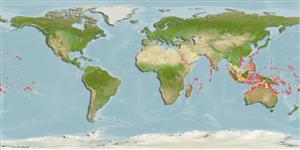Common names from other countries
Environment: milieu / climate zone / depth range / distribution range
Écologie
marin récifal; profondeur 2 - 34 m (Ref. 9710). Tropical; 30°N - 30°S
Indo-Pacific: Red Sea to the Line Islands and Samoa, north to the Ryukyu Islands, south to Reunion and New Caledonia.
Taille / Poids / Âge
Maturity: Lm ? range ? - ? cm
Max length : 9.1 cm TL mâle / non sexé; (Ref. 90102)
Épines dorsales (Total) : 8; Rayons mous dorsaux (Total) : 11 - 12; Épines anales: 3; Rayons mous anaux: 8.
Found in caves and crevices in lagoon and seaward reefs (Ref. 6180). Benthic (Ref. 75154). Secretive (Ref 90102).
Life cycle and mating behavior
Maturities | Reproduction | Spawnings | Egg(s) | Fecundities | Larves
Randall, J.E. and L. Taylor, 1988. Review of the Indo-Pacific fishes of the serranid genus Liopropoma, with descriptions of seven new species. Indo-Pac. Fish. (16):47 p. (Ref. 6180)
Statut dans la liste rouge de l'IUCN (Ref. 130435)
CITES (Ref. 128078)
Not Evaluated
Menace pour l'homme
Harmless
Utilisations par l'homme
Outils
Articles particuliers
Télécharger en XML
Sources Internet
Estimates based on models
Preferred temperature (Ref.
115969): 25.3 - 29.3, mean 28.3 (based on 2603 cells).
Phylogenetic diversity index (Ref.
82804): PD
50 = 0.5000 [Uniqueness, from 0.5 = low to 2.0 = high].
Bayesian length-weight: a=0.00389 (0.00180 - 0.00842), b=3.12 (2.94 - 3.30), in cm Total Length, based on all LWR estimates for this body shape (Ref.
93245).
Niveau trophique (Ref.
69278): 3.6 ±0.6 se; based on size and trophs of closest relatives
Fishing Vulnerability (Ref.
59153): Low vulnerability (10 of 100).
